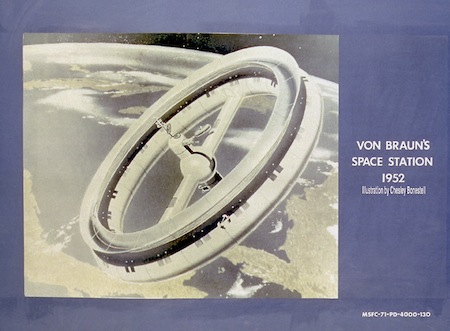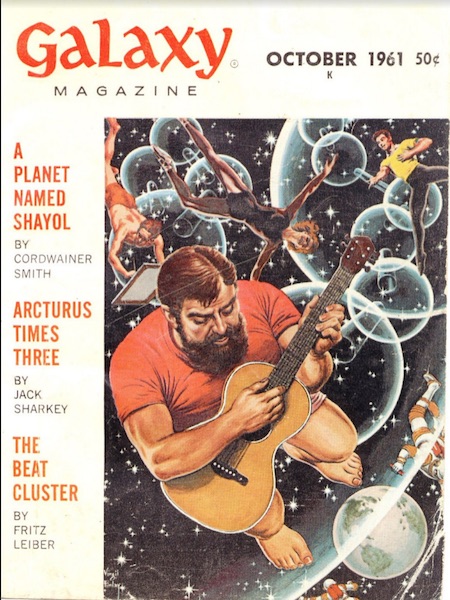Science Fiction
Dictionary
A B C D E F G H I J K L M N O P Q R S T U V W X Y Z
Seven (Ten!) Inflatable Space Structures From Science Fiction

It makes a lot of sense to use inflatable structures in space; it's the cheapest way to enclose a volume from the standpoint of weight (and therefore cost for delivery from Earth).
As far as I know, the first real proposal from scientists to use inflatable structures in space was from Werner Von Braun's 1952 article for Collier's for a flexible nylon wheel-like space station.

(Von Braun's inflatable space station concept)
Science fiction authors made steady contributions to this area both before and after.
Update 15-May-2022:
Space-Tent (Raymond Z. Gallun)
From his 1931 story The Lunar Chrysalis
I believe that it will be well for me to give a brief description of our space-tent here, for this piece of equipment was certainly sufficiently novel. It was a tiny light-weight shelter, made of a cold-resisting, rubber-like material supported on a -metal framework. It was absolutely airtight and its walls were built to resist normal earthly atmospheric pressure...
End Update.
Inflatable Roofed Valley (Robert Heinlein)
From Misfit, Heinlein's first published story (1939), a perfect choice to create an enclosed administrative area on a planetoid moved to a new orbit.
The Captain selected a little bowl-shaped depression in the hills, some thousand feet long and half as broad, in which to establish a permanent camp. This was to be roofed over, sealed, and an atmosphere provided..."Is this roof going to be just fifty feet high?"
"No, it will average maybe a hundred. It bellies up in the middle from the air pressure."
"Earth normal?"
"Half Earth normal."
Airtight Tent (Raymond Z. Gallun)
From his 1951 novella Asteroid of Fear, a family tries to set up a temporary shelter on Vesta:
In another minute John Endlich and his wife were setting up an airtight tent, which, when the time came, could be inflated from compressed-air bottles. They worked somewhat awkwardly, for their instruction period had been brief, and they were green; but the job was speedily finished. The first requirement—shelter—was assured.
Inflatable Air Lock (Murray Leinster)
From his 1951 novel Space Tug
The net and the plastic sidewalls were, of course, the method by which a really large airlock was made practical. When this ship was about to take off again, pumps would not labor for hours to pump the air out. The sidewalls would inflate and closely enclose the ship's hull, and so force the air in the lock back into the ship. Then the pumps would work on the air behind the inflated walls—with nets to help them draw the wall-stuff back to let the ship go free. The lock could be used with only fifteen minutes for pumping instead of four hours.
Inflatable Lunar Resort (Philip K. Dick)
From his 1955 novel Solar Lottery:
Corpsmen, dressed in bright vacation colors, were relaxing and enjoying themselves around and in a vast tank of sparkling blue water. Above them a dome of transparent plastic kept the fresh spring-scented air in, and the bleak void of the Lunar landscape out...
Igloo Inflatable Moon Habitat (Arthur C. Clarke)
From his 1961 novel A Fall of Moondust:
...it was now no particular hardship to live in a home that would fold up into a small trunk.This was one of the latest models - a Goodyear Mark XX - and it could sustain six men for an indefinite period, as long as they were supplied with power, water, food and oxygen. The igloo could provide everything else - even entertainment, for it had a built-in microlibrary of books, music and video... In space, boredom could be a killer...
Update 05-Jun-2022:
Inflatable Living-Globe (Fritz Leiber)
From his 1961 story The Beat Cluster:
Beyond the spherical wall loomed the other and somewhat smaller balloons of the Beat Cluster, connected to each other and to the Big Igloo by three-foot-diameter cylindrical tunnels of “triple-strength tinted sealingsilk.
('The Beat Cluster' by Fritz Leiber)
End Update.
Inflatable Expansion Bubble (Larry Niven)
From his 1967 story Flatlander.
We were in the expansion bubble when it happened. The bubble had inflatable seats and an inflatable table and was there for exercise and killing time but it also provided a fine view; the surface was perfectly transparent.
Update 25-May-2016:
Space Bubble (Bubb) (Raymond Z. Gallun)
From his 1961 story The Planet Strappers.
"A few millimeters thick, light, perfectly flexible when deflated," Nelsen added. "Cut out and cement your bubb together in any shape you choose. Fold it up firmly, like a parachute—it makes a small package that can be carried up into orbit in a blastoff rocket with the best efficiency. There, attached flasks of breathable atmosphere fill it out in a minute. Eight pounds pressure makes it fairly solid in a vacuum. So, behold—you've got breathing and living room, inside. There's nylon cording for increased strength—as in an automobile tire—though not nearly as much. There's a silicone gum between the thin double layers, to seal possible meteor punctures. A darkening lead-salt impregnation in the otherwise transparent stellene cuts radiation entry below the danger level, and filters the glare and the hard ultra-violet out of the sunshine. So there you are, all set up."
(Thanks to @fredkiesche and @nyrath (Winchell Chung) for tips!) End Update.
Update 01-Jun-2022:
Pocket Dome (Jack McDevitt)
From his 2002 story Chindi:
They set up the pocket dome in the courtyard, at the far end, away from the graves. It was simple enough, just a matter of pulling the trigger and watching it inflate itself
End Update.
Scroll down for more stories in the same category. (Story submitted 9/26/2012)
Follow this kind of news @Technovelgy.| Email | RSS | Blog It | Stumble | del.icio.us | Digg | Reddit |
Would
you like to contribute a story tip?
It's easy:
Get the URL of the story, and the related sf author, and add
it here.
Comment/Join discussion ( 0 )
Related News Stories - (" Space Tech ")
Will Space Stations Have Large Interior Spaces Again?
'They filed clumsily into the battleroom, like children in a swimming pool for the first time, clinging to the handholds along the side.' - Orson Scott Card, 1985.
Reflect Orbital Offers 'Sunlight on Demand' And Light Pollution
'I don't have to tell you about the seven two-mile-diameter orbital mirrors...'
Chrysalis Generation Ship to Alpha Centauri
'This was their world, their planet —
this swift-traveling, yet seemingly moveless vessel.' - Nat Schachner, 1934
The First Space Warship For Space Force
'Each of the electrical ships carried about twenty men...' - Garrett P. Serviss, 1898.
Technovelgy (that's tech-novel-gee!) is devoted to the creative science inventions and ideas of sf authors. Look for the Invention Category that interests you, the Glossary, the Invention Timeline, or see what's New.
Science Fiction
Timeline
1600-1899
1900-1939
1940's 1950's
1960's 1970's
1980's 1990's
2000's 2010's
Current News
The Zapata Air Scooter Would Be Great In A Science Fiction Story
'Betty's slapdash style.'
Thermostabilized Wet Meat Product (NASA Prototype)
There are no orbiting Michelin stars. Yet.
Could Crystal Batteries Generate Power For Centuries?
'Power could be compressed thus into an inch-square cube of what looked like blue-white ice'
India Ponders Always-On Smartphone Location Tracking
'It is necessary... for your own protection.'
Amazon Will Send You Heinlein's Knockdown Cabin
'It's so light that you can set it up in five minutes by yourself...'
Is It Time To Forbid Human Driving?
'Heavy penalties... were to be applied to any one found driving manually-controlled machines.'
Replace The Smartphone With A Connected Edge Node For AI Inference
'Buy a Little Dingbat... electropen, wrist watch, pocketphone, pocket radio, billfold ... all in one.'
Artificial Skin For Robots Is Coming Right Along
'... an elastic, tinted material that had all the feel and appearance of human flesh and epidermis.'
Robot Guard Dog On Duty
I might also be thinking of K-9 from Doctor Who.
Wearable Artificial Fabric Muscles
'It is remarkable that the long leverages of their machines are in most cases actuated by a sort of sham musculature...'
BrainBridge Concept Transplant Of Human Head Proposed
'Briquet’s head seemed to think that to find and attach a new body to her head was as easy as to fit and sew a new dress.'
Google's Nano Banana Pro Presents Handwritten Math Solutions
'...copy was turned out in a charming and entirely feminine handwriting.'
Edible Meat-Like Fungus Like Barbara Hambly's Slunch?
'It was almost unheard of for slunch to spread that fast...'
Sunday Robotics 'Memo' Bot Has Unique Training Glove
'He then started hand movements of definite pattern...'
Woman Marries Computer, Vonnegut's Dream Comes True
'Men are made of protoplasm... Lasts forever.'
Natural Gait With Prosthetic Connected To Nervous System
'The leg was to function, in a way, as a servo-mechanism operated by Larry’s brain...'

